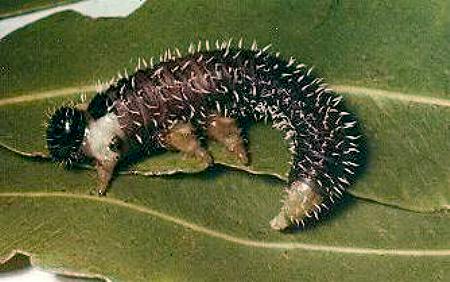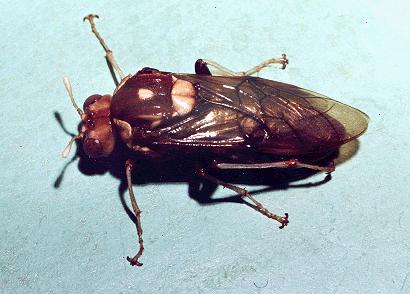
| (formerly known as Perga polita) PERGIDAE, SYMPHYTA, HYMENOPTERA | (donherbisonevans@yahoo.com ) and Stella Crossley |

(Photo: courtesy of the
Macleay Collection, Chau Chak Wing Museum, University of Sydney)

| (formerly known as Perga polita) PERGIDAE, SYMPHYTA, HYMENOPTERA | (donherbisonevans@yahoo.com ) and Stella Crossley |

(Photo: courtesy of the
Macleay Collection, Chau Chak Wing Museum, University of Sydney)
These are not true Caterpillars, but are the larvae of a wasp, or more accurately a Symphytan. When young, these larvae are so gregarious they are often found in a knotted ball of many individuals. When disturbed, they all wriggle their tails and exude a nasty yellowish fluid from their mouths. This latter habit has given them the common name of "Spitfires", although they do not actually spit the fluid, just dribble it. They use the tapping of their tails to communicate with each other.
The larvae of this species have a blue-black body with white areas, with the body tapering towards the tail. The larvae are covered in short white bristles.
The larvae are often found feeding on:
Other Sawfly species feed on other plants.
These larvae grow to a length of about 5 cms. They pupate in a dark brown cocoon in the leaf litter, and the pupal duration can be two years.

An adult insect (it is misnamed as a 'fly') is big and dark brown or black, with a white spot on the thorax, and a wing span of about 4 cms. The female lays her eggs in a slit she cuts between the upper and lower surfaces of a leaf of a food plant.
The larvae and adults of this family are quite harmless to people. They do not sting, as their cousins the communal wasps do.
This species can be found in
These larvae and adults look similar to those of other PERGINAE species, and were mistaken for Perga dorsalis or Perga affinis for many years.
Further reading :
William Elford Leach,
Descriptions of new, or interesting animals,
The Zoological Miscellany,
London : E. Nodder & Son, Vol. 3 (1817) pp. 115-116, sp. 1, and also
Plate 148, fig. 3.
Paul Whitington,
Pergagrapta species identification
Life in a Southern Forest,
Newsletter 21 (July 2024).
 not-lepidoptera |  not-caterpillars |  Lepidoptera |  not-moths |  not-lepidoptera |
(written 5 July 2025, updated 22 July 2025)